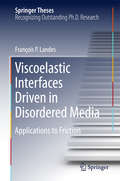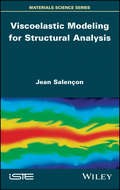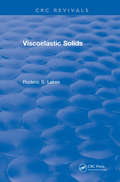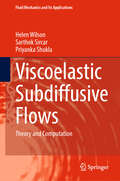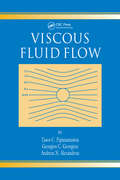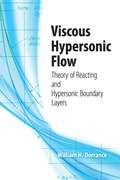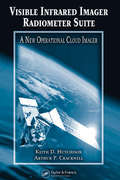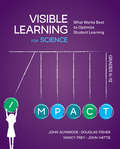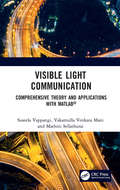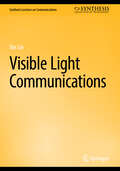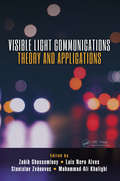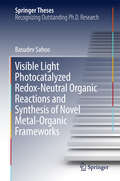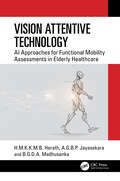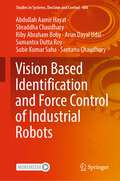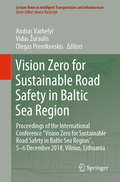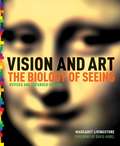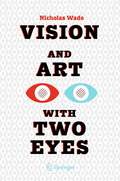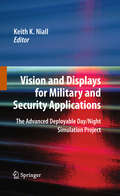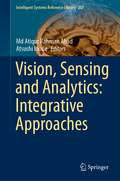- Table View
- List View
Viscoelastic Interfaces Driven in Disordered Media
by François P. LandesThis book offers an in-depth study of two well-known models of "avalanche" dynamics, modified minimally by the inclusion of relaxation. Many complex systems respond to continuous inputs of energy by accumulation of stress over time, interrupted by sudden energy releases called avalanches. The first model studied is the viscoelastic interface driven over disorder, which is shown to display the fundamental features of friction. In the mean-field limit, the friction force derived semi-analytically is compatible with laboratory experiments (displaying both velocity weakening and contact aging). In two dimensions, large-scale numerical simulations are in good agreement with the basic features of real earthquakes (Gutenberg-Richter Law, aftershock migration). The second model is a non-Markovian variant of Directed Percolation, in which we observe that the universality class is only partly modified by relaxation, a promising finding with respect to our first model.
Viscoelastic Solids (CRC Press Revivals)
by Roderic S. LakesViscoelastic Solids covers the mathematical theory of viscoelasticity and physical insights, causal mechanisms, and practical applications. The book: presents a development of the theory, addressing both transient and dynamic aspects as well as emphasizing linear viscoelasticity synthesizes the structure of the theory with the aim of developing physical insight illustrates the methods for the solution of stress analysis problems in viscoelastic objects explores experimental methods for the characterization of viscoelastic materials describes the phenomenology of viscoelasticity in a variety of materials, including polymers, metals, high damping alloys, rock, piezoelectric materials, cellular solids, dense composite materials, and biological materials analyzes high damping and extremely low damping provides the theory of viscoelastic composite materials, including examples of various types of structure and the relationships between structure and mechanical properties contains examples on the use of viscoelastic materials in preventing and alleviating human suffering Viscoelastic Solids also demonstrates the use of viscoelasticity for diverse applications, such as earplugs, gaskets, computer disks, satellite stability, medical diagnosis, injury prevention, vibration abatement, tire performance, sports, spacecraft explosions, and music.
Viscoelastic Subdiffusive Flows: Theory and Computation (Fluid Mechanics and Its Applications #138)
by Helen Wilson Sarthok Sircar Priyanka ShuklaThis book discusses the dynamical and rheological properties of high molecular weight entangled polymer melts, commonly known as viscoelastic subdiffusive fluids. Unlike dilute liquids, these materials exhibit molecular transport within a sublinear regime, meaning the timescale of diffusive transport is sublinear. The text emphasizes the potential of fractional calculus in modeling these fluids and introduces a novel fractional model to investigate regions of spatiotemporal instability in channel flows. At the microscale, the entanglement of polymer chains leads to localized, non-homogeneous regions with increased viscosity, which manifest as spatiotemporal macrostructures at the macroscale. To capture these macrostructures within the flow, direct numerical simulations are employed using a newly developed, physically realizable structure tensor, contributing to a deeper understanding of this complex class of fluids.
Viscoelasticity of Polymers
by Kwang Soo ChoThisbook offers a comprehensive introduction to polymer rheology with a focus onthe viscoelastic characterization of polymeric materials. It contains variousnumerical algorithms for the processing of viscoelastic data, from basicprinciples to advanced examples which are hard to find in the existingliterature. The book takes a multidisciplinary approach to the study ofthe viscoelasticity of polymers, and is self-contained, including the essentialmathematics, continuum mechanics, polymer science and statistical mechanicsneeded to understand the theories of polymer viscoelasticity. It coversrecent achievements in polymer rheology,such as theoretical and experimental aspects of large amplitude oscillatoryshear (LAOS), and numerical methods for linear viscoelasticity, as well as newinsights into the interpretation of experimental data. Althoughthe book is balanced between the theoretical and experimental aspects ofpolymer rheology, the author's particular interest in the theoretical side willnot remain hidden. Aimed at readers familiar with the mathematics andphysics of engineering at an undergraduate level, the multidisciplinaryapproach employed enables researchers with various scientific backgrounds toexpand their knowledge of polymer rheology in a systematic way.
Viscometry for Liquids
by S. V. GuptaThis book is written for scientists involved in the calibration of viscometers. A detailed description for stepping up procedures to establish the viscosity scale and obtaining sets of master viscometers is given in the book. Uncertainty considerations for standard oils of known viscosity are presented. The modern viscometers based on principles of tuning fork, ultrasonic, PZT, plate waves, Love waves, micro-cantilever and vibration of optical fiber are discussed to inspire the reader to further research and to generate improved versions. The primary standard for viscosity is pure water. Measurements of its viscosity with accuracy/uncertainty achieved are described. The principles of rotational and oscillation viscometers are explained to enhance the knowledge in calibration work. Devices used for specific materials and viscosity in non SI units are discussed with respect to the need to correlate viscosity values obtained by various devices. The description of commercial viscometers meets the needs of the user.
Viscous Fluid Flow
by Tasos Papanastasiou Georgios Georgiou Andreas N. Alexandrou"With the appearance and fast evolution of high performance materials, mechanical, chemical and process engineers cannot perform effectively without fluid processing knowledge. The purpose of this book is to explore the systematic application of basic engineering principles to fluid flows that may occur in fluid processing and related activities.In Viscous Fluid Flow, the authors develop and rationalize the mathematics behind the study of fluid mechanics and examine the flows of Newtonian fluids. Although the material deals with Newtonian fluids, the concepts can be easily generalized to non-Newtonian fluid mechanics. The book contains many examples. Each chapter is accompanied by problems where the chapter theory can be applied to produce characteristic results.Fluid mechanics is a fundamental and essential element of advanced research, even for those working in different areas, because the principles, the equations, the analytical, computational and experimental means, and the purpose are common.
Viscous Hypersonic Flow: Theory of Reacting and Hypersonic Boundary Layers
by William H. DorranceThis frequently cited text addresses theories for treating the laminar and turbulent boundary layers of reacting gas mixtures. The theories are developed from fundamentals, and all related chemical, thermodynamic, and physical concepts are described in a fashion that provides a self-contained treatment. In addition, the book presents useful equations for calculating heat transfer between reacting gas boundary layers and reacting, melting, sublimating, and otherwise decomposing surfaces. Designed for advanced undergraduate and graduate engineering courses in modern boundary-layer theory, this volume also serves as a valuable reference for professionals. Along with its thorough coverage of the theories for treating reacting laminar and turbulent boundary layers, the text also describes the underlying theories and methods of calculating transport and thermodynamic properties for dilute gas mixtures. Certain useful concepts from thermochemistry are also examined in detail. All theories are developed from the fundamentals, with a focus on the basic physics of interactions between like and unlike particles and the roles these interactions play in determining the transport properties of reacting gas mixtures.
Visible Infrared Imager Radiometer Suite: A New Operational Cloud Imager
by Keith D. Hutchison Arthur P. CracknellThe Visible Infrared Imager Radiometer Suite (VIIRS) is the next-generation multispectral imaging instrument to fly on US operational, polar-orbiting meteorological satellites. VIIRS will gather data across 22 spectral bands and be used to create products for a variety of applications including weather forecasting and climate change studies. VIIRS
Visible Learning for Science, Grades K-12: What Works Best to Optimize Student Learning
by Douglas Fisher John Hattie Dr Nancy Frey John T. AlmarodeInquiry, laboratory, project-based learning, discovery learning—which science instructional approach is most effective? In Visible Learning for Science, the authors reveal that it’s not which strategy, but when, and plot a vital K-12 framework for choosing the right approach at the right time, depending on where students are within the three phases of learning: surface, deep, and transfer. Synthesizing state-of-the-art science instruction and assessment with John Hattie’s cornerstone educational research, this book empowers you to plan, develop, and implement high-impact instruction at each phase so all students demonstrate more than a year’s worth of learning for every year in school.
Visible Learning for Science, Grades K-12: What Works Best to Optimize Student Learning
by Douglas Fisher John Hattie Dr Nancy Frey John T. AlmarodeInquiry, laboratory, project-based learning, discovery learning—which science instructional approach is most effective? In Visible Learning for Science, the authors reveal that it’s not which strategy, but when, and plot a vital K-12 framework for choosing the right approach at the right time, depending on where students are within the three phases of learning: surface, deep, and transfer. Synthesizing state-of-the-art science instruction and assessment with John Hattie’s cornerstone educational research, this book empowers you to plan, develop, and implement high-impact instruction at each phase so all students demonstrate more than a year’s worth of learning for every year in school.
Visible Light Communication
by Shlomi ArnonVisible light communication (VLC) is an evolving communication technology for short-range applications. Exploiting recent advances in the development of high-power visible-light emitting LEDs, VLC offers an energy-efficient, clean alternative to RF technology, enabling the development of optical wireless communication systems that make use of existing lighting infrastructure. Drawing on the expertise of leading researchers from across the world, this concise book sets out the theoretical principles of VLC, and outlines key applications of this cutting-edge technology. Providing insight into modulation techniques, positioning and communication, synchronisation, and industry standards, as well as techniques for improving network performance, this is an invaluable resource for graduate students and researchers in the fields of visible light communication, optical wireless communication, and industrial practitioners in the field of telecommunications.
Visible Light Communication Based Indoor Localization
by Mohsen Kavehrad Reza AminikashaniThis book demonstrates the research on VLC based indoor localization in four aspects: first, it constructs the concept and model of the system; second, positioning algorithms, as the main issue in indoor localization, are detailed; third, many approaches are proposed to further improve the positioning performance; fourth, challenges will be detailed. Impulse response with multipath reflections are analyzed. Orthogonal frequency division multiplexing (OFDM) is proposed, and positioning performance is largely improved compared to On-off-keying (OOK) modulation. The readers will get a broad view of VLC based indoor localization from the background to the future challenges.
Visible Light Communication: Comprehensive Theory and Applications with MATLAB®
by Mathini Sellathurai Suseela Vappangi Vakamulla Venkata ManiThe field of visible light communication (VLC) has diverse applications to the end user including streaming audio, video, high-speed data browsing, voice over internet and online gaming. This comprehensive textbook discusses fundamental aspects, research activities and modulation techniques in the field of VLC. Visible Light Communication: A Comprehensive Theory and Applications with MATLAB® discusses topics including line of sight (LOS) propagation model, non-line of sight (NLOS) propagation model, carrier less amplitude and phase modulation, multiple-input-multiple-output (MIMO), non-linearities of optical sources, orthogonal frequency-division multiple access, non-orthogonal multiple access and single-carrier frequency-division multiple access in depth. Primarily written for senior undergraduate and graduate students in the field of electronics and communication engineering for courses on optical wireless communication and VLC, this book: Provides up-to-date literature in the field of VLC Presents MATLAB codes and simulations to help readers understand simulations Discusses applications of VLC in enabling vehicle to vehicle (V2V) communication Covers topics including radio frequency (RF) based wireless communications and VLC Presents modulation formats along with the derivations of probability of error expressions pertaining to different variants of optical OFDM
Visible Light Communications (Synthesis Lectures on Communications)
by Xin LinThis book describes the methods and application of Visible Light Communication (VLC) and covers topics such as light sources, detectors, VLC systems, optical modulation schemes, optical multiple-access techniques, new VLC standards, and current applications including ubiquitous indoor information services, visible-light wireless LAN (LiFi), underwater optical wireless communications, and VLC with art.
Visible Light Communications: Modulation and Signal Processing (IEEE Series on Digital & Mobile Communication)
by Zhaocheng Wang Wei Huang Qi Wang Zhengyuan XuA complete and comprehensive reference on modulation and signal processing for visible light communication This informative new book on state-of-the-art visible light communication (VLC) provides, for the first time, a systematical and advanced treatment of modulation and signal processing for VLC. Visible Light Communications: Modulation and Signal Processing offers a practical guide to designing VLC, linking academic research with commercial applications. In recent years, VLC has attracted attention from academia and industry since it has many advantages over the traditional radio frequency, including wide unregulated bandwidth, high security, and low cost. It is a promising complementary technique in 5G and beyond wireless communications, especially in indoor applications. However, lighting constraints have not been fully considered in the open literature when considering VLC system design, and its importance has been underestimated. That’s why this book—written by a team of experts with both academic research experience and industrial development experience in the field—is so welcome. To help readers understand the theory and design of VLC systems, the book: Details many modern techniques on both modulation and signal processing aspects Links academic research with commercial applications in visible light communications as well as other wireless communication systems Combines theoretical rigor with practical examples in presenting optical camera communication systems Visible Light Communications: Modulation and Signal Processing serves as a useful tool and reference book for visible light communication professionals, as well as wireless communication system professionals and project managers. It is also an important guide for undergraduates and graduates who want to conduct research in areas of wireless communications.
Visible Light Communications: Theory and Applications
by Zabih Ghassemlooy Luis Nero Alves Stanislav Zvanovec Mohammad-Ali KhalighiVisible Light Communications, written by leading researchers, provides a comprehensive overview of theory, stimulation, design, implementation, and applications. The book is divided into two parts – the first devoted to the underlying theoretical concepts of the VLC and the second part covers VLC applications. Visible Light Communications is an emerging topic with multiple functionalities including data communication, indoor localization, 5G wireless communication networks, security, and small cell optimization. This concise book will be of valuable interest from beginners to researchers in the field.
Visible Light Photocatalyzed Redox-Neutral Organic Reactions and Synthesis of Novel Metal-Organic Frameworks
by Basudev SahooThis unique thesis discusses the development of conceptually novel and synthetically valuable methods that use visible light photocatalysis. Each chapter addresses a different topic in the emerging field of photocatalysis, which has become an indispensable tool for organic synthesis. Photocatalysis employs environmentally harmless and abundant visible light in the presence of a photosensitizer, and as such offers an attractive alternative to harmful UV light in photo-mediated reactions. This book introduces the novel concept of merging gold catalysis with visible light photocatalysis in a dual catalytic fashion, which demonstrates their compatibility with each other for first time and has inspired the development of various reactions. Moreover, a novel trifluoromethylation method, which combines radical addition chemistry with a polar rearrangement to synthesize valuable fluorinated compounds, is presented, since compounds featuring fluorinated functionality are the subject of increasing attention in pharmaceutical, agrochemical and material research. It also develops an external photocatalyst-free photochemical method for the synthesis of valuable indolizine heterocycles, where the product mediates its own formation. Lastly, it describes the synthesis and characterization of two novel highly porous metal-organic frameworks (MOFs). The comprehensive text is rounded out with illustrations and color figures.
Vision Attentive Technology: AI Approaches for Functional Mobility Assessments in Elderly Healthcare
by B.G.D.A. Madhusanka H.M.K.K.M.B. Herath A.G.B.P. JayasekaraThis book provides a comprehensive overview of the use of vision attentive technology and artificial intelligence methodologies for functional mobility assessment in elderly populations.Vision Attentive Technology and Functional Mobility Assessment in Elderly Healthcare, begins with a general introduction to vision-attentive technology and its uses in the care of older people. Next it examines functional mobility in senior populations and offers a critique of the methods used today for evaluation. The authors then present several artificial intelligence approaches and vision-aware systems used for screening age related diseases such as Parkinson's disease and sarcopenia. The book also presents the difficulties and possibilities of using visual attentive technology to identify functional impairments caused by aging.This book would be helpful to researchers in the field of healthcare, especially those interested in using technology to enhance patient outcomes. Geriatricians, physical therapists, and occupational therapists who treat older patients will also benefit from reading this book. It will also be helpful to readers who are studying biomedical engineering, artificial intelligence, and healthcare.
Vision Based Identification and Force Control of Industrial Robots (Studies in Systems, Decision and Control #404)
by Subir Kumar Saha Santanu Chaudhury Abdullah Aamir Hayat Shraddha Chaudhary Riby Abraham Boby Arun Dayal Udai Sumantra Dutta RoyThis book focuses on end-to-end robotic applications using vision and control algorithms, exposing its readers to design innovative solutions towards sensors-guided robotic bin-picking and assembly in an unstructured environment. The use of sensor fusion is demonstrated through a bin-picking task of texture-less cylindrical objects. The system identification techniques are also discussed for obtaining precise kinematic and dynamic parameters of an industrial robot which facilitates the control schemes to perform pick-and-place tasks autonomously without any interference from the user. The uniqueness of this book lies in a judicious balance between theory and technology within the context of industrial application. Therefore, it will be valuable to researchers working in the area of vision- and force control- based robotics, as well as beginners in this inter-disciplinary area, as it deals with the basics and technologically advanced research strategies.
Vision Zero for Sustainable Road Safety in Baltic Sea Region: Proceedings of the International Conference “Vision Zero for Sustainable Road Safety in Baltic Sea Region”, 5–6 December 2018, Vilnius, Lithuania (Lecture Notes in Intelligent Transportation and Infrastructure)
by Olegas Prentkovskis Andras Varhelyi Vidas ŽuraulisThis book gathers papers presented at the International Conference “Vision Zero for Sustainable Road Safety in Baltic Sea Region”, held on December 2018 at Vilnius Gediminas Technical University, in Vilnius, Lithuania. Taking as a starting point the multi-national road traffic safety program Vision Zero, originated in Sweden in 1995, the book aims at showing the current situation in different countries, in terms of achieved results and new challenges in both policy implementation and available technologies. A special emphasis is given to themes such as safety of smart vehicles, human factors, public education, and urban planning. The book offers an extensive source of information and ideas concerning innovative transportation technologies and infrastructure. It addresses both researchers and decision-makers in this field.
Vision and Art
by Margaret S. Livingstone David Hubel<p>With the original release of Vision and Art in 2002, Harvard professor Margaret Livingstone successfully bridged the gap between science and art, exploring how great painters fool the brain: why Mona Lisa’s smile seems so mysterious, or Monet’s Poppy Field appears to sway. In the revised and expanded edition, Livingstone presents two new chapters of her latest observations, has substantially expanded other chapters, and updates the rest of the existing text with new insights gleaned from her ongoing research, bringing the book to the cutting edge in the field of neuroscience. <p>Accompanying Livingstone’s lively prose are many charts and diagrams that lucidly illustrate her points, as well as in-depth analyses of the phenomena found in major works of art. Be it the explanation of common optical illusions or the breakdown of techniques painters use to create those illusions, Vision and Art provides a wealth of information for artists, scholars, and scientists alike.</p>
Vision and Art with Two Eyes (Vision, Illusion and Perception #3)
by Nicholas WadeThis book celebrates binocular vision by presenting illustrations that require two eyes to see the effects of cooperation and competition between them. Pictures are flat but by printing them in different colours and viewing them through similarly coloured filters (included with the book) they are brought to life either in stereoscopic depth or in rivalry with one another. They are called anaglyphs and all those in the book display the ways in which the eyes interact. Thus, the reader is an integral element in the book and not all readers will see the same things. The history, science and art of binocular vision can be experienced in ways that are not usually available to us and with images made specifically for this book. The study of vision with two eyes was transformed by the invention of stereoscopes in the early 19th century. Anaglyphs are simple forms of stereoscopes that have three possible outcomes from viewing them – with each eye alone to see the monocular images, with both eyes to see them in stereoscopic depth or rivalry, or without the red/cyan glasses where they can have an appeal independent of the binocularity they encompass. Through the binocular pictures and the words that accompany them there will be an appreciation of just how remarkable the processes are that yield binocular singleness and depth. Moreover, the opportunities for expressing these processes are explored with many examples of truly binocular art.
Vision and Displays for Military and Security Applications
by Keith K. NiallThe book discusses advances in projection technologies used for simulation in military and security applications. More specifically, the subject of this book is using high-resolution projection display technology for simulating night vision device conditions while increasing the distance that objects can be simulated under simulated daylight conditions. Topics covered include: advances in high-resolution projection, advances in image generation, advances in geographic modelling or photogrammetric technologies, night vision goggle human factors research, night vision goggle training techniques. The book will have special features including graphs and systems operational architectural diagrams specific to these domains. The main benefit the reader will gain from this book is that it will present leading edge methods for conducting human factors research for night vision device research, while also presenting leading edge technologies used design and apply visual displays for current simulations.
Vision, Sensing and Analytics: Integrative Approaches (Intelligent Systems Reference Library #207)
by Atsushi Inoue Md Atiqur Rahman AhadThis book serves as the first guideline of the integrative approach, optimal for our new and young generations. Recent technology advancements in computer vision, IoT sensors, and analytics open the door to highly impactful innovations and applications as a result of effective and efficient integration of those. Such integration has brought to scientists and engineers a new approach —the integrative approach. This offers far more rapid development and scalable architecting when comparing to the traditional hardcore developmental approach. Featuring biomedical and healthcare challenges including COVID-19, we present a collection of carefully selective cases with significant added- values as a result of integrations, e.g., sensing with AI, analytics with different data sources, and comprehensive monitoring with many different sensors, while sustaining its readability.
